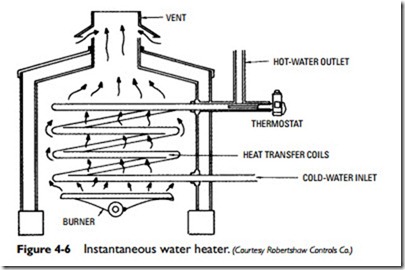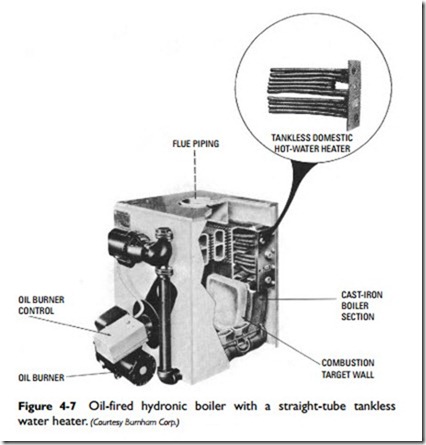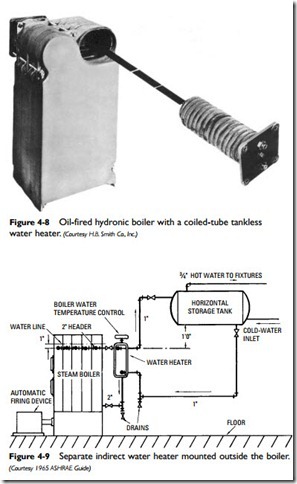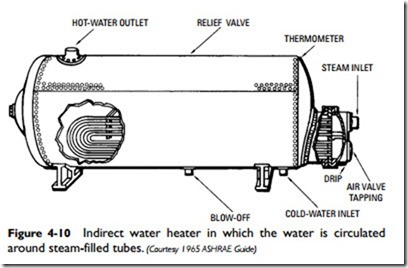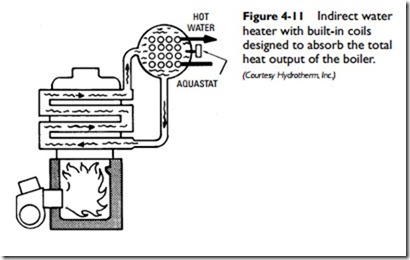Instantaneous Water Heaters
Automatic instantaneous water heaters (also sometimes called point-of-use water heaters) are self-contained units available in capacities ranging up to 445 gallons per hour (or up to 7.43 gallons per minute at 100° temperature rise) (see Figure 4-6).
Basically, an instantaneous heater consists of a large copper coil suspended over a series of burners. The copper coil, burners, valves, and thermostats are all enclosed in a protective steel casing. An instantaneous water heater does not have a hot-water storage tank; this feature distinguishes them from other types of commercial water heaters, such as the multicoil and multiflue.
The water to be heated circulates through the copper coil. The operating principle of these heaters is very simple and ideal for situations requiring intermittent use. Any pressure drop in the system (such as that caused by opening a faucet) provides the necessary power to force open the gas valve and allow gas to flow to the burners. The gas is ignited by the pilot, and the water in the coil is
heated to the desired temperature. These heaters are ideally suited for those public buildings or sites that require periods of high demand (for example, public washrooms, sports arenas, ballparks, stadiums, or recreational centers).
Indirect Water Heaters
An indirect water heater uses either steam or hot water to heat the water used in the domestic hot-water supply system.
In small, residential-type boilers, a water heater element consisting of straight copper tubes with U-bends or a coiled tube is located in the hottest portion of the boiler water (see Figures 4-7 and 4-8). It is positioned at the side of the boiler to create rapid natural circulation. Because there is no separate water storage tank, this type of unit is commonly called a tankless water heater.
In steam boilers, the copper tubes are generally placed below the water line in the boiler. The system is designed so that the water is heated after a single passage through the copper tubes.
Another type of indirect water heater utilizes a separate water heater outside the boiler (see Figure 4-9). Hot water from the boiler flows into the heater and around copper coils containing the domestic hot-water supply before returning to the boiler. The water inside the coils is heated and returned to a hot-water storage tank, which is usually located at a level slightly higher than the heating boiler.
The water to be heated can also be circulated around tubes through which steam is circulated. The steam tubes are submerged in a steel tank as shown in Figure 4-10. As in all methods of indirect heating, the domestic water supply is kept sealed off from the hot water or steam being used to heat it.
Indirect water heaters of the type illustrated in Figure 4-11 are essentially space-heating boilers with built-in coil bundles through which the hot water circulates. They differ from hot-water space- heating boilers in the following two ways:
1. The coils are sized to absorb the total output of the boiler.
2. Water temperatures do not exceed 210°F.
These indirect water heaters may be used as instantaneous heaters. Because they can be used with any size storage tank, there is no real upper limit on their storage capacity. The same is true of their recovery rate.
The principal advantages of an indirect water heater are the following:
2. Scale formation and corrosion in the secondary heat exchanger coils are minimized because of the relatively low operating temperatures.
3. No hot-water storage tank (with the accompanying circulator, controls, and piping) is required if the heater has been prop- erly sized.
